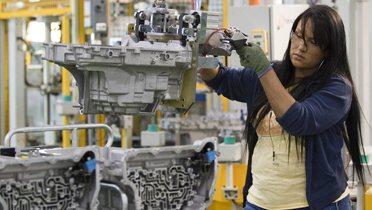In a New York Times op-ed, Christina Romer, the former chair of President Obama’s Council of Economic Advisors, argues—contra her former boss—that there is no compelling justification for policies aimed at supporting U.S. manufacturing. She lays out and rejects a few theoretical justifications for supporting manufacturing, including the idea that there are large positive externalities—large social benefits relative to what private companies can capture—tied to the sector. Her arguments are unconvincing. Most important, there are large social benefits associated with innovation and manufacturing plays an outsized role in creating them. In so doing, manufacturing makes a disproportionate contribution to economic growth.
Romer ignores the strong evidence that company research and development (R&D) is worth much than the companies capture. For example, Charles Jones and John Williams estimate that R&D spending would have to quadruple to be high enough to meet the nation’s needs. Some economists have estimated that R&D’s rate of return to the nation as a whole (not just to the companies that pay for it) is as high as 30 percent. There are also positive externalities associated with less formal innovations such as improvements in production processes. Like the results of R&D, these innovations can be copied or adapted by competitors.
As one of us has written for a forthcoming Brookings report, all of these inventive activities and innovative accomplishments would be vastly diminished without the manufacturing sector. Although it makes up only about 11 percent of GDP, manufacturing accounts for 68 percent of all domestic R&D spending by companies in the United States. While only about 9 percent of all U.S. jobs are in manufacturing, 35 percent of all engineers work in manufacturing. National Science Foundation data show that only 8 percent of all non-manufacturing companies introduced a new product or service between 2006 and 2008, while 22 percent of manufacturing companies did so. The same percentages apply to the share of companies that added a new production or business process. Finally, corporate tax data from the IRS reveal that 60 percent of income from royalties from intellectual property goes to manufacturing firms.
The innovation spillovers that manufacturers produce flow throughout the U.S. economy, not just to other manufacturers. The gains are especially large at the regional scale because—contrary to Romer’s misinterpretation of the literature—companies perform better when they are located near many other firms than when they are more geographically isolated. When a manufacturing establishment relocates offshore, the related companies in the region suffer disproportionately.
Even aside from geographic linkages, manufacturing firms are tightly linked to innovation in the U.S. service sector. For example, high-technology services such as Internet services, telecommunications, computer systems design, and scientific research depend on R&D in manufacturing. When a manufacturer moves production offshore, the skilled researchers and engineers it used to employ in this country are no longer available to high technology service providers. As the regional benefits of that knowledge creation emerge and grow in the foreign location, a larger share of inter-related service activities (including management, administration, marketing, logistics, legal, and information technology) also relocate offshore to be closer to the center of production.
Romer mentions tax breaks, trade restrictions, and direct government investment in specific industries as examples of wrongheaded policies aimed to support manufacturing. In fact, though, there are a wide variety of sensible policies that the federal government could adopt to counteract the market failures associated with innovation—market failures that result in large part from manufacturing’s outsized contribution to innovation. Desirable policies include improving the training of workers without four-year degrees, strengthening R&D tax credits, and expanding assistance to small and medium-sized manufacturers to help them improve their economic performance.
Meanwhile, at the regional and state level, there are also many useful interventions available to policymakers. Regional leaders can attempt to leverage their specific strengths in the sector and shore up their weaknesses by observing various capacities with respect to invention and research capacity, workforce skills, access to finance, and infrastructure needs. Improvements along these lines can benefit manufacturers and avoid wasteful corporate giveaways to business. Given manufacturing’s special contribution to regional and national economies, such interventions would likely be well worth the investment.
The Brookings Institution is committed to quality, independence, and impact.
We are supported by a diverse array of funders. In line with our values and policies, each Brookings publication represents the sole views of its author(s).





Commentary
The Outsized Benefits of U.S. Manufacturing
February 6, 2012